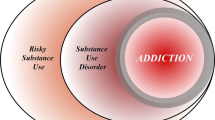Abstract
This article examines ‘the NIDA paradigm’, the theory that addiction is a chronic, relapsing brain disease characterized by loss of control over drug taking. I critically review the official history of the National Institute on Drug Abuse (NIDA) paradigm and analyze the sources of resistance to it. I argue that, even though the theory remains contested, it has yielded important insights in other fields, including my own discipline of history.
Similar content being viewed by others
References
Acker, C.J. (2002) Creating the American Junkie: Addiction Research in the Classic Era of Narcotic Control. Baltimore, MD: Johns Hopkins University Press.
Alexander, B. (2008) The Globalization of Addiction: A Study in Poverty of the Spirit. New York: Oxford University Press.
Angell, M. (2009) Drug companies and doctors: A story of corruption. New York Review of Books 56 (15 January): 8–12.
Beith, M. (2009) Mexico needs an intervention. Newsweek 154 (10 August/17 August): 8.
Brandt, A.M. (2007) The Cigarette Century: The Rise, Fall, and Deadly Persistence of the Product that Defined America. New York: Basic Books.
Campbell, N.D. (2007) Discovering Addiction: The Science and Politics of Substance Abuse Research. Ann Arbor, MI: University of Michigan Press.
Castel, R. (2008) Closing remarks, International Conference on Drugs and Culture, Sciences Po, Paris, 13 December.
Chernow, R. (1998) Titan: The Life of John D. Rockefeller, Sr. New York: Random House.
Condon, T.P. (2006) Reflecting on 30 years of research: A look at how NIDA has advanced the research, prevention, and treatment of drug abuse and addiction. Behavioral Healthcare 26 (May): 14–16.
Conrad, P. (2007) The Medicalization of Society: On the Transformation of Human Conditions into Treatable Disorders. Baltimore, MD: Johns Hopkins University Press.
Courtwright, D.T. (2001a) Dark Paradise: A History of Opiate Addiction in America. Cambridge, MA: Harvard University Press.
Courtwright, D.T. (2001b) Forces of Habit: Drugs and the Making of the Modern World. Cambridge, MA: Harvard University Press.
Courtwright, D.T. (forthcoming, title tentative) The Illusion of Conservatism. Cambridge, MA: Harvard University Press, in press.
Courtwright, D.T. (2005) Mr ATOD's wild ride: What do alcohol, tobacco, and other drugs have in common? Social History of Alcohol and Drugs 20: 105–140.
Degler, C.N. (1991) In Search of Human Nature: The Decline and Revival of Darwinism in American Social Thought. New York: Oxford University Press.
DeGrandpre, R. (2006) The Cult of Pharmacology: How America Became the World’s Most Troubled Drug Culture. Durham, NC: Duke University Press.
Drug Enforcement Administration. (2009) Methamphetamine, http://www.usdoj.gov/dea/concern/meth.html.
Duster, T. (2006) Comparative perspectives and competing explanations: Taking on the newly configured reductionist challenge to sociology. American Sociological Review 71: 1–15.
Kolb, L. (1962) Drug Addiction: A Medical Problem. Springfield, IL: Charles C. Thomas.
Kuhar, M. (2010) Contributions of basic science to understanding addiction. BioSocieties 5 (1): 25–35.
Kuhn, T.S. (1970) The Structure of Scientific Revolutions, 2nd edn. Chicago, IL: The University of Chicago Press.
Leshner, A.I. (2001) Addiction is a brain disease. Issues in Science and Technology Online, http://www.issues.org/17.3/leshner.htm.
Maisel, A.Q. (1945) Getting the drop on dope. Liberty (24 November), unpaginated reprint, ‘US Bureau of Narcotics – History’, vertical files, DEA Library, Arlington, VA.
Massing, M. (1998) The Fix. New York: Simon and Schuster.
National Aeronautics and Space Administration. (1992) NASA Spinoffs: 30 Year Commemorative Edition. Washington DC: NASA Technology Transfer Division.
National Institute on Drug Abuse. (2008) Drugs, Brains, and Behavior: The Science of Addiction, revised edn. Washington DC: National Institute on Drug Abuse.
Nixon, R. (1973) Tape 393-11B, Nixon Presidential Library and Museum, http://www.nixonlibrary.gov/forresearchers/find/tapes/tape393/tape393.php.
Peele, S. (1998) The Meaning of Addiction: An Unconventional View. San Francisco, CA: Jossey-Bass.
Sanders, L. (2008) Fewer dopamine receptors makes for risky business. Science News, 30 December.
Satel, S. (2009) The addicted patient. Presentation at Addiction, the Brain, and Society, Emory University, February 2009.
Vrecko, S. (2010) ‘Civilizing technologies’ and the control of deviance. BioSocieties 5 (1): 36–51.
Author information
Authors and Affiliations
Additional information
†The author has never applied for NIDA funding and has no conflicts of interest.
Rights and permissions
About this article
Cite this article
Courtwright, D. The NIDA brain disease paradigm: History, resistance and spinoffs. BioSocieties 5, 137–147 (2010). https://doi.org/10.1057/biosoc.2009.3
Published:
Issue Date:
DOI: https://doi.org/10.1057/biosoc.2009.3



